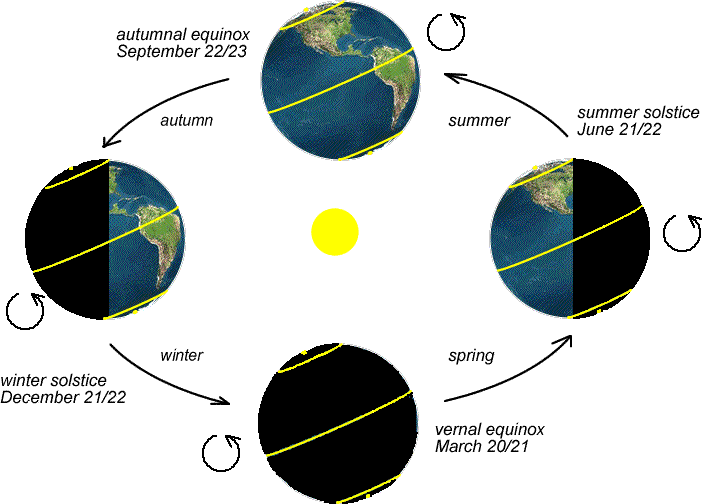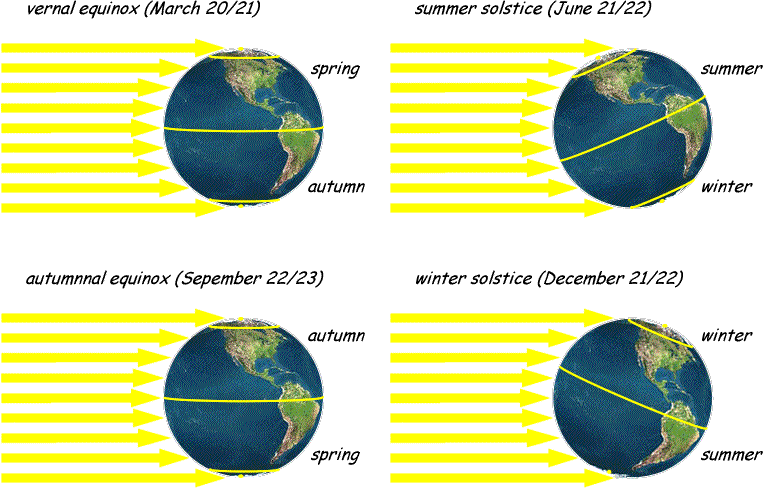
|
| [NMSU, N. Vogt] |
Let us now explore all four of the seasons on Earth. The figure below shows the relationship between the 23 (23.5, to be precise) degree tilt of the Earth, and the pattern of the seasons as the Earth moves around the Sun each year. The arrows show the direction of the Earth's rotation on its own axis every day, and its revolution around the Sun each year. The yellow circles on each Earth indicate the position of the Arctic and Antarctic Circles (23 degrees away from the poles), and the Equator. The Tropic of Cancer (+23 degrees) and the Tropic of Capricorn (-23 degrees) are not shown. Click on the figure, and you will see the pattern of light and darkness (day and night) posed by portions of the Earth facing toward and away from the Sun.

|
| [NMSU, N. Vogt] |
The solstices are the days on which the Earth's axis points either directly toward or directly away from the Sun, one in winter, and one in summer. The equinoxes are the days on which the Earth's axis points neither away nor toward the Sun, the days during which night and day are of equal length throughout the world.
The second figure shows the same four seasons on Earth. Our viewpoint has shifted, and we see the Earth as it would appear from above the north pole. Click on the figure, and the shadows caused by portions of the Earth facing toward and away from the Sun will disappear.

|
| [NMSU, N. Vogt] |
In December, the northern hemisphere is tiled away from the Sun. There are two specific effects which contribute to cause the seasons. (1) The surface of the northern hemisphere is hidden in the Earth's shadow for more than 12 hours of the day, making the days shorter and the nights longer. (2) The Sun rises far in the south, and never moves high enough above the horizon to stand directly above us, even at noon. The surface of the Earth is thus quite inclined to the incoming sunlight, and so there is less sunlight to absorb per unit area and the climate is cooler. This is exactly the same as the poles receiving less light than the equator in our first case, as was shown in the second figure above (right hand side).
At the same time, the southern hemisphere is tilted toward the sun. The surface is lit up by the Sun for more than 12 hours per day, and so the days are longer. The Sun rises to the north, but not the far north, and is found overhead at noon. The surface of the Earth is inclined perpendicular to the sunlight (as in the left hand side of figure 2), and so receives the maximum amount of sunlight per square area.
The situation is most extreme at the north and south poles. At the north pole, the season is one long,cold night which last for six months. At the south pole, the Sun never sets and it is warm for six months continuously.
In March, the two hemispheres have 12 hour days and nights and receive roughly equal amounts of light. The Sun rises at the equator, and the closer to the equator that we stand the higher that it rises in the sky at midday. Notice that this even-handed state persists in all three of the three cases which we have considered (the Earth tilted by zero, 23, or 90 degrees) – why is this?
In June, the situation is reversed from December. The northern hemisphere is tilted toward the sun, and enjoys longer days and more sunlight during the day. The southern hemisphere is tilted away from the Sun, hidden in the shadow of the Earth for more than 12 hours every day, and when the Sun is shining it receives less sunlight per unit area.

|
| [NMSU, N. Vogt] |
September has weather very much like June. The two hemispheres have 12 hour days and nights and receive roughly equal amounts of light. The northern hemisphere has autumn weather because it is transitioning from summer to winter (the days start out long and get slowly shorter and cooler), while the southern hemisphere has spring weather because it is moving from winter to summer (the days start out short and get slowly longer and warmer).
The figure below shows the Earth at each of the four seasons, and the sunlight which falls upon at different latitudes. Can you see how the rays of sunlight come down at different angles (allowing more or less sun per unit area on the Earth), as the Earth's tilt causes the northern and southern hemispheres to shift toward and away from the Equator?
Where on Earth does the sunlight radiate from directly overhead, on the summer solstice? on the winter solstice? on the equinoxes? Does the sunlight ever radiate from directly overhead at the north and south poles?

|
| [NMSU, N. Vogt] |